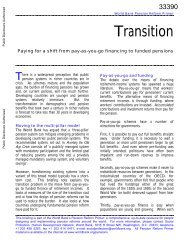Financial Sector Development in Africa: Opportunities ... - World Bank
Financial Sector Development in Africa: Opportunities ... - World Bank
Financial Sector Development in Africa: Opportunities ... - World Bank
You also want an ePaper? Increase the reach of your titles
YUMPU automatically turns print PDFs into web optimized ePapers that Google loves.
Hous<strong>in</strong>g F<strong>in</strong>ance 113<br />
Figure 4.1<br />
Mortgage Debt as a Percent of GDP<br />
Percent<br />
35<br />
30<br />
25<br />
20<br />
15<br />
10<br />
5<br />
0<br />
South <strong>Africa</strong><br />
Namibia<br />
Morocco<br />
Tunisia<br />
Kenya<br />
Senegal<br />
Algeria<br />
Uganda<br />
Cameroon<br />
Nigeria<br />
Country<br />
Source: <strong>World</strong> <strong>Bank</strong> mortgage debt database, 2010.<br />
Note: Data are the latest available and vary between 2004 and 2009.<br />
Ghana<br />
Egypt, Arab Rep.<br />
Tanzania<br />
Chad<br />
Central <strong>Africa</strong>n Republic<br />
Gabon<br />
Gu<strong>in</strong>ea<br />
Congo, Rep.<br />
70 percent for the United States and 50 percent for Europe. If you take<br />
out South <strong>Africa</strong>, the rate falls to 2 percent of GDP. If you then take out<br />
North <strong>Africa</strong>n countries, the rate for Sub-Saharan <strong>Africa</strong> falls to under<br />
1 percent of GDP. In those countries where it does exist—such as<br />
Tanzania, Uganda, Ghana, and Nigeria—the number of loans is rarely<br />
more than a few thousand. These loans are also often limited to the<br />
wealthiest segment of the population, who pose the lowest credit risk.<br />
This means that the exist<strong>in</strong>g loans are far from subprime and are typically<br />
issued only after extensive documentation requirements, large down payments,<br />
and often additional guarantees from an employer or other forms<br />
of collateral besides the property.<br />
An alternative to mortgage lend<strong>in</strong>g that has proved popular <strong>in</strong> develop<strong>in</strong>g<br />
the hous<strong>in</strong>g f<strong>in</strong>ance system <strong>in</strong> South America is hous<strong>in</strong>g microf<strong>in</strong>ance.<br />
This medium-term f<strong>in</strong>anc<strong>in</strong>g can allow for much more rapid <strong>in</strong>cremental<br />
construction and some bulk buy<strong>in</strong>g of materials. There is extremely limited<br />
<strong>in</strong>formation on this form of f<strong>in</strong>anc<strong>in</strong>g, but other than some <strong>in</strong>itiatives<br />
<strong>in</strong> South <strong>Africa</strong> it has yet to develop to any significant scale <strong>in</strong> <strong>Africa</strong>. In<br />
part, this reflects the slower development of microf<strong>in</strong>ance more generally<br />
<strong>in</strong> <strong>Africa</strong> than <strong>in</strong> other regions, as well as the cont<strong>in</strong>ent’s much lower<br />
urban densities. The density of urban areas may have helped accelerate<br />
the development of hous<strong>in</strong>g microf<strong>in</strong>ance <strong>in</strong> the South American context<br />
where lenders are able to benefit from reduced distribution costs.







